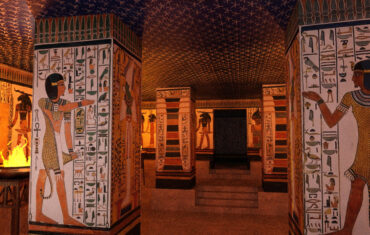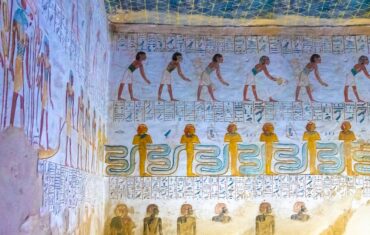The Pyramid of Menkaure, or Menkaura, is the cenotaph of Pharaoh Neter Menkaura. Located about 450 meters southwest of the pyramid of Chefren, it is the smallest of the three pyramids of the plain: the structure is now with a height of 62 meters on a square base with the side of about 103 meters.
Menkaure’s untimely death negatively affected the development of construction: it was built on several occasions, employing different techniques and materials. The striking peculiarity is the size of the stone blocks with which it was built, much larger than those used for the other pyramids present in the same necropolis.
The original design included a total red granite cover of the quarries of Aswan, but to complete the upper part was used the white limestone of Tura, not smoothed and therefore probably not finished. The granite cladding, over the centuries, has been removed and repurposed for the construction of other works.
The other elements that make up the entire funeral complex were carried out by his son Shepseskaf, his successor. In 1196 a breach was opened to search for the precious funerary kit of the Pharaoh, of which the signs remain externally.
The interior of the pyramid appears very complex in its structure: at the entrance, oriented to the north about 4 meters high, there is a greenery covered in pink granite of about 32 meters and with a 26-degree inclination that leads to a vestibule decorated with bas-reliefs with the motif of “palace façade” and a subsequent large square corridor.
From this street, 6 meters below the ground level, you get to the original burial chamber that has a pit to accommodate the sarcophagus and from which starts a blind corridor that originally should have led to the outside of the pyramid. After the change of the pyramid design, the location of the burial chamber was moved oriented to the north-south axis: concealed by a paving slab we find the Sarcophagus Crypt, a compartment of almost 15 square meters that presents itself with a height of 3 and a half meters.
The marks left on the walls by the workers’ tools during construction indicate that the lower corridor was dug from the inside out, while the upper one from the outside to the inside. Also attached to the pyramid are the Funeral Temple and the Temple to the Valley.
The first construction, begun using stone, for urgent cult needs was finished with the use of raw brick plastered, less resistant, which despite numerous restorations during the 6th dynasty, did not hold up to the passage of time.
In the Temple in the Valley there is the Shrine, where the famous statues of the Sovereign were found: eight Triads in which the Pharaoh is accompanied by two Gods.





